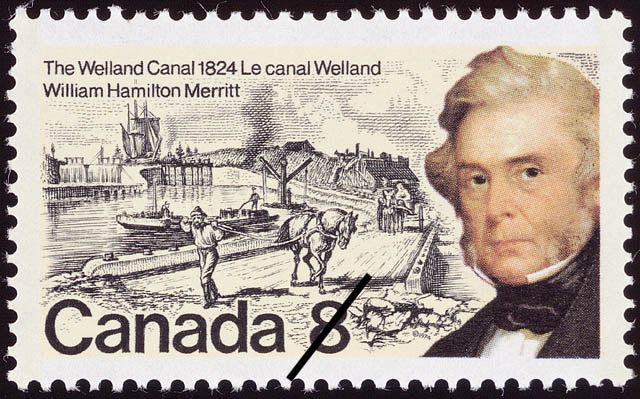On today’s date in 1932, the fourth and current Welland Canal – officially known as the Welland Ship Canal – opened to traffic in the Niagara Region.
The 43-kilometre canal traverses the Niagara Peninsula from Port Weller to Port Colborne, connecting the northern Lake Ontario with the southern Lake Erie, the latter of which is about 100 metres higher in elevation. The canal includes eight 24.4-metre-wide ship locks, seven of which (Locks 1-7, also known as the “lift locks”) are more than 230 metres long and raise or lower passing ships between 13 metres and 15 metres each. The southernmost lock (Lock 8, also known as the “guard lock”) is nearly 350 metres in length.
There were three previous canals in the Welland area dating back to about 1830, but the canal’s roots can be traced back to 1824, when the Welland Canal Company was incorporated in Upper Canada after a petition by nine “freeholders of the District of Niagara.”
Each year, about 40 million tonnes of cargo are carried through the Welland Canal by about 3,000 Great Lakes- and ocean-faring vessels. Throughout the 19th century, the canal heavily contributed to the growth of Toronto, which is located on Lake Ontario’s north-west coast. The original canal allowed goods to be shipped from other Great Lakes ports and major industrial cities to Québec, where they could be reloaded onto ocean-faring vessels for international shipping.
FIRST TRIAL RUN IN 1829
Construction began in Allanburg, Ont., shortly after the petition was signed.
On Nov. 30, 1829 – exactly five years after the ground-breaking in 1824 – the canal opened for a trial run.
It ran from Port Dalhousie, leaving Lake Ontario and traveling south along Twelve Mile Creek to St. Catharines, where it wound up the Niagara Escarpment through Merritton and into Thorold. From there, it continued south via Allanburg to Port Robinson along the Welland River.
Ships then travelled east on the Welland River to Chippawa, where they made a sharp turn into the Niagara River and south towards Lake Erie. The section between Allanburg and Port Robinson was originally planned as a subterranean tunnel, but the sandy soil made the project infeasible.
1833 EXTENSION
In 1833, a southern extension from Port Robinson opened with the founding of Port Colborne on the north coast of Lake Erie.
The extension ran south along the Welland River to Welland, which was then only a small settlement called Aqueduct, the name of which paid tribute to the wooden aqueduct that carried the canal over the river. The extension then split south to Port Colborne.
1974 CANAL STAMP
In 1974, Canada’s Post Office Department (now Canada Post) commemorated the Welland Canal and one of Niagara’s freeholders, William Merritt, on an eight-cent stamp (Scott #655) to mark the centenary of the famed shipping route.
Born on July 3, 1793, in Bedford, N.Y., Merritt and his family settled in present-day St. Catharines in 1796. By 1811, Merritt founded a general store and began farming.
“The War of 1812 interrupted business, however, and Merritt joined the militia which he left in 1815 with the rank of Captain, after several campaigns and eight months of captivity by the Americans,” reads a press release issued by the Post Office Department in 1974. “The conflict with the Americans didn’t prejudice Merritt towards them and within three years of the war’s end, he set to work on what was to be his life’s ambition, ‘to make Canada the avenue of trade between Great Britain and the western states.'”
In 1818, he and eight other “freeholders of the District of Niagara” petitioned the legislature about a potential canal that could bypass Niagara Falls.
“Upper Canada had long needed such a project to secure naval supremacy over the United States on Lake Erie and to avoid dependence on American trade routes,” adds the press release. “A slump in agricultural prices and a customs dispute between Upper and Lower Canada postponed the task until 1824 but by then Merritt, ‘the eager, pushing, incurably romantic promoter,’ and his colleagues had raised enough money to begin the canal which, with plenty of support from the government and American investors, was ready for traffic by 1829.”
Financial stability, however, “was not immediately forthcoming,” reads the Post Office Department press release.
“The Welland Canal depended heavily on local American traffic and was eventually nationalized in 1841 because of financial embarrassments. Canadians were not unanimous in their praise of the great achievement and William Lyon Mackenzie went so far as to accuse Merritt of charging his ‘expenses in London for clubs, theatre tickets, cigars and gin,’ to the company. Whatever the initial reception, the canal eventually became the kingpin of the transport system linking the Great Lakes with the Atlantic.”
Designed by William Rueter, the stamp depicts life along the Welland Canal in 1824. While the left-facing portrait of Merritt is based on a circa 1860 oil painting by Robert Whale, the depiction of the Welland Canal is a steel-engraved interpretation based on an original wood-engraved illustration entitled “Lock No. 23 Thorold.”
According to the Post Office Department, the illustration was taken from George Monro Grant’s Picturesque Canada, which was published in 1882.
Printed by the Canadian Bank Note Company and American Bank Note Company, the stamp has general tagging along two opposing sides.


